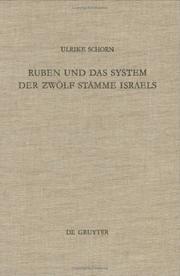| Listing 1 - 10 of 18 | << page >> |
Sort by
|
Book
ISBN: 3825221571 3525032315 Year: 2000 Publisher: Göttingen Vandenhoeck & Ruprecht
Abstract | Keywords | Export | Availability | Bookmark
 Loading...
Loading...Choose an application
- Reference Manager
- EndNote
- RefWorks (Direct export to RefWorks)
222 --- Historische boeken van het Oude Testament --- Bible OT

ISBN: 2892611318 Year: 1995 Publisher: Montréal XYZ
Abstract | Keywords | Export | Availability | Bookmark
 Loading...
Loading...Choose an application
- Reference Manager
- EndNote
- RefWorks (Direct export to RefWorks)
222 --- 222.5 --- 82.09 --- Historische boeken van het Oude Testament --- Jozua. Rechters. Ruth --- Literaire kritiek --- 82.09 Literaire kritiek
Book
ISBN: 907168007X Year: 1987 Volume: vol *12 Publisher: Mechelen Leuven Werkgroep Sacerdos Vlaamse Bijbelstichting
Abstract | Keywords | Export | Availability | Bookmark
 Loading...
Loading...Choose an application
- Reference Manager
- EndNote
- RefWorks (Direct export to RefWorks)
Ancien Testament --- Oude Testament --- 222 --- #gsdb12 --- #GROL:SEMI-22<08> Dich 7 --- #GROL:SEMI-222.1 --- Historische boeken van het Oude Testament --- Pastores, liturgisch en Bijbel-geïnteresseerden
Book
ISBN: 9004060170 0585308357 9789004060173 Year: 1979 Volume: 30 Publisher: Leiden Brill
Abstract | Keywords | Export | Availability | Bookmark
 Loading...
Loading...Choose an application
- Reference Manager
- EndNote
- RefWorks (Direct export to RefWorks)
Bible --- 222 --- #GROL:SEMI-221<08> Supp 30 --- Historische boeken van het Oude Testament --- Bible. --- Historical Books (Books of the Old Testament)
Book
ISBN: 9004513736 9004513744 9789004513730 9789004513747 Year: 2022 Publisher: Leiden ; Boston : Brill
Abstract | Keywords | Export | Availability | Bookmark
 Loading...
Loading...Choose an application
- Reference Manager
- EndNote
- RefWorks (Direct export to RefWorks)
The Deuteronomistic History contains many vast troop and casualty numbers. What purpose does this literary device of numerical hyperbole serve? What rhetorical purposes do any of the numbers in this text serve? In The Rhetorical Use of Numbers in the Deuteronomistic History: “Saul Has Killed His Thousands, David His Tens of Thousands,” Denise Flanders explores the variety of rhetorical effects that numbers have on the narrative of Joshua–2 Kings. Flanders demonstrates that numbers in Joshua–2 Kings often work in surprising and subversive ways. Rather than regularly glorifying a leader, large casualty numbers may actually anticipate a ruler’s downfall. Rather than underscoring an Israelite battle victory, numbers sometimes qualify or undermine the triumph of victories.
Numbers in the Bible --- Deuteronomistic history (Biblical criticism) --- 222 --- 222 Historische boeken van het Oude Testament --- 222 Livres historiques de l'Ancien Testament --- Historische boeken van het Oude Testament --- Livres historiques de l'Ancien Testament --- Deuteronomic history (Biblical criticism) --- Deuteronomists (Biblical criticism) --- DH (Biblical criticism) --- D document (Biblical criticism) --- Biblical numerology
Book
ISBN: 372780792X 9783727807923 Year: 1992 Volume: 115 Publisher: Freiburg Universitätsverl.
Abstract | Keywords | Export | Availability | Bookmark
 Loading...
Loading...Choose an application
- Reference Manager
- EndNote
- RefWorks (Direct export to RefWorks)
Middle Eastern literature --- Relation to the Old Testament --- Bible --- Theology --- Comparative studies --- 222 --- -Near Eastern literature --- Historische boeken van het Oude Testament --- -Historische boeken van het Oude Testament --- Bible. --- Antico Testamento --- Hebrew Bible --- Hebrew Scriptures --- Kitve-ḳodesh --- Miḳra --- Old Testament --- Palaia Diathēkē --- Pentateuch, Prophets, and Hagiographa --- Sean-Tiomna --- Stary Testament --- Tanakh --- Tawrāt --- Torah, Neviʼim, Ketuvim --- Torah, Neviʼim u-Khetuvim --- Velho Testamento --- Comparative studies. --- Theology. --- Middle Eastern literature - Relation to the Old Testament
Book
ISBN: 8876537112 9788876537110 Year: 2020 Volume: 223 Publisher: Roma G&B Press
Abstract | Keywords | Export | Availability | Bookmark
 Loading...
Loading...Choose an application
- Reference Manager
- EndNote
- RefWorks (Direct export to RefWorks)
Visions in the Bible --- 224 --- 222 --- 229*232 --- 229*232 Visioen van Daniel --- Visioen van Daniel --- 222 Historische boeken van het Oude Testament --- 222 Livres historiques de l'Ancien Testament --- Historische boeken van het Oude Testament --- Livres historiques de l'Ancien Testament --- 224 Livres prophetiques de l'Ancien Testament --- 224 Profetische boeken van het Oude Testament --- Livres prophetiques de l'Ancien Testament --- Profetische boeken van het Oude Testament --- Bible. --- Criticism, interpretation, etc. --- Visions in the Bible. --- Symbolism in the Bible.

ISBN: 3110117363 311084947X 9783110117363 Year: 1989 Volume: 178 Publisher: Berlin De Gruyter
Abstract | Keywords | Export | Availability | Bookmark
 Loading...
Loading...Choose an application
- Reference Manager
- EndNote
- RefWorks (Direct export to RefWorks)
Bible --- Antiquity --- Israel --- Jews --- -Historiography --- History --- -222 --- -Hebrews --- Israelites --- Jewish people --- Jewry --- Judaic people --- Judaists --- Ethnology --- Religious adherents --- Semites --- Judaism --- Historische boeken van het Oude Testament --- 222 --- -Historische boeken van het Oude Testament --- -Jews --- Hebrews --- History&delete& --- Historiography --- Bible. --- Antico Testamento --- Hebrew Bible --- Hebrew Scriptures --- Kitve-ḳodesh --- Miḳra --- Old Testament --- Palaia Diathēkē --- Pentateuch, Prophets, and Hagiographa --- Sean-Tiomna --- Stary Testament --- Tanakh --- Tawrāt --- Torah, Neviʼim, Ketuvim --- Torah, Neviʼim u-Khetuvim --- Velho Testamento --- Criticism, interpretation, etc. --- Historiography. --- -Bible --- History of Biblical events --- To 1200 B.C --- Sources --- Bible. Old Testament --- Criticism, interpretation, etc --- Jews - Historiography - History - To 1200 B.C
Book
ISBN: 9789056155902 9056155903 Year: 2022 Publisher: Gorredijk Sterck & De Vreese
Abstract | Keywords | Export | Availability | Bookmark
 Loading...
Loading...Choose an application
- Reference Manager
- EndNote
- RefWorks (Direct export to RefWorks)
Migraties en deportaties tekenen de geschiedenis van de mensheid. De bijbelse uittocht van het volk Israël uit de slavernij van Egypte naar het Beloofde Land is hiervan een iconisch voorbeeld. 0Intrigerend is de vraag naar de historische kern van het Exodusverhaal. Waren er inderdaad Israëlieten aanwezig in Egypte tijdens de faraonische periode? Is er een wetenschappelijke verklaring voor de bijbelse plagen? Wanneer vond de Exodus precies plaats? En hoe zit het met de doortocht door de Rode Zee en de militaire verovering van Kanaän door de Israëlieten? De Exodus inspireerde door de eeuwen heen vele westerse kunstenaars. Hun werk bepaalde in grote mate onze beeldvorming van de diverse verhaalelementen. 0Marleen Reynders maakt een duidelijk onderscheid tussen het historische bronnenmateriaal en de theologische betekenis ervan. Zij laat zien dat dit bijbels bevrijdingsepos is bedoeld om de grootsheid van Jahweh en de unieke alliantie tussen deze god en zijn volk te onderstrepen en dat het de kern van het Joodse geloof vormt.00Marleen Reynders is egyptoloog en musicoloog. Ze geeft lezingen en gastcolleges in binnen- en buitenland, begeleidt cultuurreizen en is auteur van verschillende boeken over het oude Egypte.
Migration. Refugees
---
Ancient history
---
Bible OT. Pentateuch. Exodus
---
Middle East
---
222
---
325

ISBN: 3110153963 1306400414 3110830396 9783110153965 Year: 1997 Volume: 248 Publisher: Berlin ; New York Walter de Gruyter
Abstract | Keywords | Export | Availability | Bookmark
 Loading...
Loading...Choose an application
- Reference Manager
- EndNote
- RefWorks (Direct export to RefWorks)
Douze tribus d'Israel --- Ruben (Biblical character) --- Ruben (Bijbelse karakter) --- Ruben (Caractère biblique) --- Twaalf stammen van Israel --- Twelve tribes of Israel --- 222 --- Historische boeken van het Oude Testament --- Bible. Old Testament --- Criticism [Redaction ] --- Twelve tribes of Israel. --- First-born children in the Bible. --- Reuben
| Listing 1 - 10 of 18 | << page >> |
Sort by
|

 Search
Search Feedback
Feedback About UniCat
About UniCat  Help
Help News
News